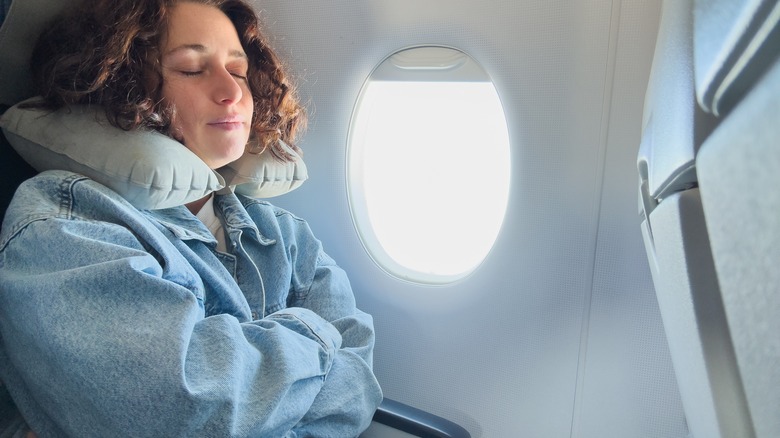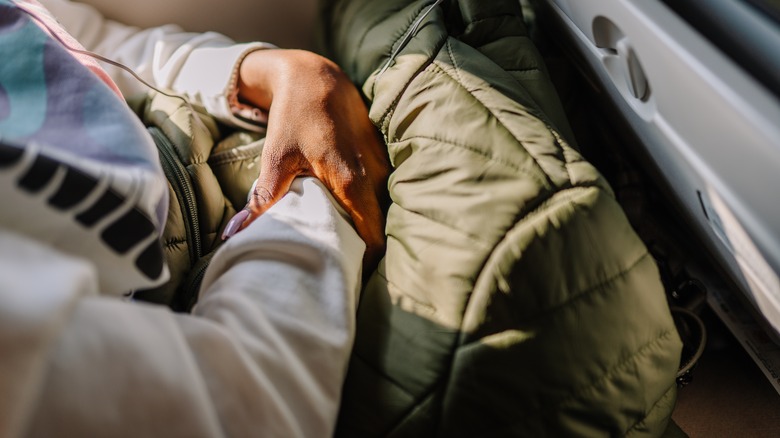Pack This TSA-Approved Camping Item In Your Carry-On To Make Flights Feel Cozier
If you've ever shivered your way through a flight before, you're not alone. In fact, plenty of travelers know the feeling all too well: Airplanes can get really, really cold. But, despite the discomfort, this drop in temperatures isn't just random. There are many reasons for a cold cabin, including for reducing the risk of dehydration at high altitudes, preventing passengers from fainting because of pressure changes, and accommodating the different body temperatures in a plane full of people (it's a lot easier to add layers if you're cold than to try and cool down if you're too warm).
And while some passengers might resort to just bringing a TSA-approved extra blanket onboard, wearing cozy socks, or packing their favorite hoodie (even if they're traveling to a much hotter destination), these added precautions aren't always enough for people who get cold easily. Especially when you consider the fact that some seats might feel colder than others on an airplane, depending on their location.
Thankfully, though, the Transportation Security Administration (TSA) allows passengers to bring one more item that can help solve the issue: hand and foot warmers. Typically used for camping, hiking, and other outdoor activities, these warming packs are approved for both carry-on and checked baggage (with some exceptions) according to their regulations. Available in several different styles — including air-activated types that use iron powder, reusable gel and liquid-based warmers, and battery-powered options — most hand and foot warmers are all designed with one common goal in mind: to generate enough heat that'll keep your hands and feet toasty for hours.
The ins and outs of flying with hand warmers
Although the TSA's official website notes that flying with hand warmers is allowed, there are a handful of things to consider before simply throwing them into your bag. For starters, there's the issue with the different types of warmers out there and their specific regulations. As a pro tip, most disposable, air-activated warmers made with iron powder, carbon, and salt aren't considered hazardous materials. This means you can technically pack as many as you want in either your carry-on or checked luggage. Better yet, these types of warmers typically last anywhere from six to 10 hours, which also makes them perfect for long-haul flights. For example, this pack of TSA-friendly hand warmers can come in very handy (no pun intended) if you're worried about getting too cold on your upcoming flight.
That said, reusable gel-based warmers aren't as easy to bring along. Since they contain liquids/gel, these types of warmers must follow the TSA's 3-1-1 liquid rule — which means that they can't be any larger than 3.4 ounces and must also fit inside your quart-sized clear bag with all of your toiletries. Ultimately, these make them a lot less convenient than their disposable counterparts.
Lastly, battery-powered electric hand warmers are also allowed and can be a great option for longer trips and frequent travelers. However, keep in mind that any items that use lithium-ion batteries are amongst the most common electronics that you should avoid putting in your checked luggage for safety reasons, which means you'll always have to pack them in your carry-on for any other flight you might take.
Other ways to stay warm on a flight
Beyond hand warmers, staying cozy on a flight doesn't have to be a battle of discomfort and frustration. As an overall strategy, layering is still one of the most effective ways to regulate your temperature — even when cabin temperatures start to fluctuate. Ideally, you'll want to start with a moisture-wicking base layer that keeps sweat away from your skin, then add an insulating middle layer like a light sweater, and top it all off with a removable outer layer that you can put on and take off as needed.
Along with that, a large scarf or shawl is also one of the best things you can wear on a flight. Whether you can use it as a wrap around your shoulders, a makeshift blanket, or even roll it up as a pillow, having an extra removable layer handy can help you adjust a lot easier than if you were only traveling with a large jacket or hoodie (too hot!).
Finally, staying hydrated during your flight is also essential for regulating body temperature. Although typically associated with feeling hot and sweaty, dehydration can sometimes make you feel colder than you actually are. That said, try your best to avoid any excess alcohol and caffeine (both of which can contribute to fluid loss), and pack some extra hydration tablets in your carry-on to help you stay properly hydrated throughout your entire journey.


